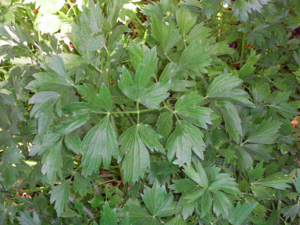Lovage

Lovage (Levisticum officinale) is a vigorous, hardy perennial herb. Lovage is cold hardy. Lovage grows to a height of around 1.5 metres at its maturity after four years.
Description[edit | edit source]
Lovage has hollow stems. The shiny leaves appear like those of celery or French parsley. They smell strongly of celery.
Lovage will grow to a height of about 2 metres (7 feet). It's a big plant and one alone is sufficient for a family.
The flowers are yellow, large and flat-topped. These appear in the middle of summer.
Other varieties of lovage[edit | edit source]
- Scots lovage (Levisticum scoticum)
Growing lovage[edit | edit source]
It is easy to grow lovage from seed or from root pieces. Plant in the spring or autumn.[1] Established plants can be lifted and divided in the spring; replant the side shoots. If transplanting lovage, this must be done very early in its growth as it develops a very long tap root.
In a sunny and open position, select an area with rich and moist soil, deeply dug. Light shade will improve its flavour.[1]
If sowing seeds, use freshly ripened ones and plant in midsummer. Sow 12mm (1/2 in.) deep in drills to sow the seeds.
Caring for lovage[edit | edit source]
Expect lovage to die back completely during the winter. Mark the area to avoid planting something else there. Take the leaves and dry them for winter use before it dies back.
To capture seeds, remove the seed heads when turning brown. Place upside down in a paper bag to catch the seeds as they drop, or roll the seed heads and help them fall into the bag. Store in resealable bags or sealed containers.
Uses for lovage[edit | edit source]
The leaves, stems, roots and seeds of lovage are all edible.[1] The younger leaves are the best for culinary use, as they are the most tender.[1] A little goes a long way.
The hollow stems of lovage can be used in the same way as celery. They have a spicy and peppery flavour, useful for stews, soups, salads and casseroles.
Lovage seeds can be added to cakes, biscuits (cookies) and bread to add some piquancy.
The leaves can be used in tea.[1]
During the winter months, the root can be used and dried leaves. To use the roots, lift when the plant is two to three years old, wash and dry. Store them in a cool place until needed.[1]